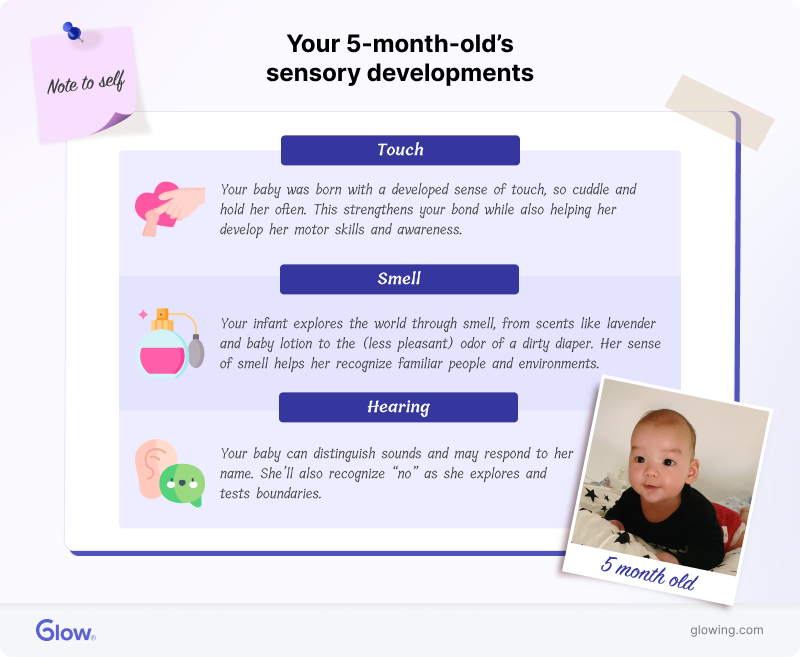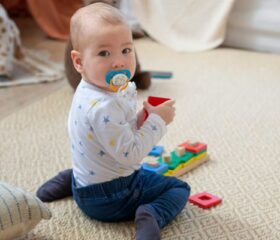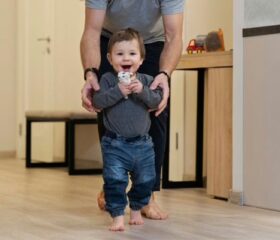Baby Month by Month
5-Month-Old Baby
Your baby is beginning to understand object permanence.

This month, your little one’s sensory development is skyrocketing. As it does, your baby will start showing off that adorable personality of hers even more. Let’s take a look at how your baby is progressing and how to keep her happy and healthy at 5 months old.
Your baby’s 5-month milestones
Someone’s baby clothes are starting to get tight! At 5 months old, most baby boys are approximately 26 inches tall and weigh around 16 pounds. Girls, on the other hand, are around 25 inches tall and weigh about 15 pounds. 1 2
If your little one is clocking in a little heavier or lighter than the average for her age, don’t worry. There’s no one-size-fits-all for babies (pun intended), and she’s probably doing just fine. Still, if you’re concerned about her height or weight, your pediatrician is just a phone call away.
Here’s what else is happening this month:
Your baby’s visual development
Those little eyes of hers are developing like you wouldn’t believe, and she’s picking up some new skills this month, such as:
- Object permanence: Your baby’s beginning to understand that just because a toy has disappeared from view, it hasn’t ceased to exist. This means you can now try out games like peek-a-boo, which will hopefully be the cause of plenty of tummy-shaking laughter.
- Facial recognition: She’s also beginning to recognize familiar faces and objects from a distance. She can see you from across a room and will smile to say hi.
- Perception: Your baby can see colors—although not as many as you—and has a sense of depth perception, which helps her pick out three-dimensional objects.
- Object recognition: She can also now recognize things she’s previously interacted with by only seeing a part of them.
These developments will help your baby’s hand and eye coordination improve. Keep her eyes busy with a brightly colored mobile and lots of varied toys to help her hone these skills.

Your 5-month-old’s other sensory developments
It’s not just her eyes that are hard at work—her other senses are being tantalized by all that life has to offer.
- Touch: Your baby was born with a developed sense of touch, so make sure you stimulate it by cuddling and holding her. Physical touch triggers the release of the “love hormone” (oxytocin), which further strengthens your bond. 3 Other actions, like bouncing her on your knee, will improve her environmental awareness and motor skills, as well as soothe her.
- Smell: Your infant uses her sense of smell to learn about the world. From the intoxicating fragrances of lavender, baby lotion, and baby food to the less desirable stink of her own diaper, her nose is busier than ever before.
- Hearing: Your little one’s hearing has reached a point where she can differentiate between sounds. If she hasn’t already, she’ll start paying attention to how you speak and may now respond to her name. 4
Your 5-month-old’s vocalization and communication
It just got a whole lot noisier in your house (if it wasn’t already from all the crying).
You may notice your little one making sounds like “ba,” “ga,” and “da,” and combining them to form longer strings of syllables. These sounds aren’t real words, but you’ll learn that she uses them to telegraph her wants and moods.
At this stage, your baby is making the connection between certain noises and their associated reactions, like crying and getting attention. 5
The Centers for Disease Control and Prevention (CDC) encourages talking to your baby and repeating the sounds she makes. You can also sing to her to help build her communication skills. 6
Your 5-month-old’s physical development
Someone’s been working out! Your little one’s muscles are getting stronger, and she’s now capable of several new movements:
- Rolling: At 5 months, your baby’s found an excellent new means of transportation: rolling. Keep a close eye on her as she tumbles around.
- Looking up: Your little one is also gaining upper body strength, and you may see her pushing up on her elbows while lying on her tummy. As she gets stronger, you’ll find she can hold her head up for longer periods without support. You can take this as a sign that she’s ready to try sitting with the support of pillows. 7
- Reaching: She’s becoming aware of her hands and will grasp at and reach for things. You’ll notice her stretching out with both hands, touching her fingers, and banging things against surfaces. At this point, she’ll also practice transferring items from one hand to another.
- Mimicking: Your baby will probably start emulating your own movements this month. Join her on the floor and give her a clearer view of your body to encourage this. 8
- Playing: Lastly, she’s getting acquainted with cause and effect. She may start dropping things like pacifiers or food from a high chair and watching them go “splat” on the ground below. While it means your house may be perpetually messy, for her, it’s a great learning experience.
Feeding your 5-month-old baby
At 5 months old, your baby needs about 6–7 ounces of milk per feeding. She’ll drink between five and six bottles per day (or if she’s nursing, the same amount of breast milk). 9
How to know when your baby is ready for solid food
This month could mark another big milestone for your baby—introducing her to solids. If you’re wondering when the right time to do this is, the answer lies with your tot. She’ll give you the cues.
You’ll mainly introduce solids as a form of exploration and learning. Breast milk and formula will still be her main food source for at least the first 6 months.
Your baby may already be letting you know she’s ready for more than a liquid diet if: 9
- She can sit upright in her high chair or infant seat.
- She can control her head, which means it doesn’t loll when she’s sitting up.
- She swallows food when you spoon it into her mouth instead of pushing it back out.
- She opens her mouth in anticipation when you offer her food.
Don’t be discouraged if your baby rejects solids at first. However great a cook you may be, your little one needs time to adjust to the new textures, smells, and tastes, and it may take a few tries to convince her.
What foods to feed your baby
If you see the signs that she’s ready to explore solids, you can start with small portions of cereal mixed with breast milk or formula, or pureed:
- Sweet potatoes
- Squash
- Carrots
- Bananas
- Avocado
- Applesauce
You should start this process slowly, introducing one new food every 3–5 days, so you can spot any food allergies as they spring up.
Introduce only small amounts of common allergens at first
So long as your pediatrician doesn’t tell you otherwise, you can introduce small amounts of common allergens, such as peanuts or eggs. Start with only a little at first (e.g., 1/8 of a teaspoon of peanut butter in her oatmeal) and closely monitor her for signs of an allergic reaction.
Precautions when feeding your baby solids
Your baby’s gums are still tender at this age. To avoid irritating them, use a small plastic (or plastic-coated) spoon.
These sessions will get decorative, and you may want to tie a bib around your little chomper’s neck. Don’t be shy about using one yourself if you need one.
Sleep and your 5-month-old baby
Your baby’s sleep patterns will be more predictable at 5 months old. She’ll likely get the same amount of sleep that she did as a newborn, albeit with fewer but longer bouts.
Most 5-month-olds need between 12 and 16 hours of sleep every 24 hours. This includes longer stretches of sleep at night—many babies start sleeping through the night for 6–8 hours at a time.
The time when your baby is awake between naps and nighttime sleep is known as a “wake window.” Your baby’s wake windows increase with age, and at 5 months old, she’ll also reduce her daytime sleeping schedule from three naps to two, each lasting 1–2 hours. 10
Training your baby to sleep
Training your baby to sleep means teaching her to do it without your help. According to experts, there’s no better time than 5 months to do this. 11
Sleep training requires putting your baby to bed at the same time every night and tucking her in while she’s sleepy, but still awake (instead of waiting until she nods off and carrying her there). It requires persistence and patience.
There are several methods you can follow, including a gradual “no-tears” method and a quicker but more trying cry-it-out method. Sleep training isn’t a one-size-fits-all activity, and if you’re not sure whether to slowly introduce this new bedtime routine or bite the bullet and do it all at once, it’s never a bad idea to ask your pediatrician for advice.
Sleep safety
The American Academy of Pediatrics (AAP) recommends that babies sleep in the same room as their parents—but not in the same bed—until they’re at least 6 months old, and, ideally, until they’re 12 months old. 12
This will make nursing her easier and more convenient, give you a little peace of mind, and make it possible to react immediately if she gets sick, falls out of her crib, or has trouble breathing in the night (all of which are rare, but which can still happen to fragile 5-month-olds).
How to get your baby ready for bedtime
You can get your baby into her bedtime mode with a:
- Warm bath
- Gentle massage
- Lullaby
- White noise machine
Always place your baby on her back in her cot with a firm mattress. Avoid using crib bumpers, loose blankets, pillows, or stuffed animals. Although these can prevent her from rolling to the sides, they put her at risk of suffocation.
Note that if your baby has learned to roll, swaddling her is no longer safe, and it’s time to lower the mattress in the crib.
General health and safety
Odds are, you don’t have a well-baby visit scheduled for your infant’s fifth month, so it’s up to you to monitor her health.
Common ailments
Your baby may have a few minor aches and ailments this month, including:
- Teething: Babies can start teething as early as 3 months old. Yours may drool, become increasingly fussy, and get colic. She’ll appreciate teething toys or a cold, wet washcloth to soothe her. 13
- Pee and poop issues: Your 5-month-old baby should wet her diapers at least five times daily. As for poop, it’s normal for babies to go as long as 2 days without filling up their diapers, so don’t be alarmed if she’s not pooping every day. Breastfed babies, in general, tend to poop more than formula-fed babies. 14 Watch for irregular consistency, diarrhea, blood in the stool, or anything that shouldn’t be there.
- Spitting up: This should not be as common at this age as it used to be earlier in your baby’s infancy. Contact your doctor if it persists, increases, or affects your baby’s weight.
- Skin conditions: Check in with your doctor if your baby has been dealing with skin issues like baby acne, different types of diaper rashes, a flaky scalp (cradle scalp), or eczema, especially if they persist despite home treatments. They will be able to provide personalized recommendations to help resolve these common problems.
When to keep your baby home from daycare
Keep your little one home if she has:
- A fever: A temperature of 100.4°F or more constitutes a fever. Don’t send her to daycare if she has one.
- Vomiting and diarrhea: Vomiting more than twice in 24 hours or loose stools (not caused by a change in diet) are signs your baby is unwell. Stools that contain more than just a drop of blood or mucus are as big a warning sign, and mandate an immediate call to your doctor. 15
- Persistent coughing: As you’d expect, coughing and wheezing both suggest your little one has a respiratory condition. Look out for a runny nose and thick mucus.
- A new rash: If your baby has sprouted a new, undiagnosed rash, keep her home, especially if her rash comes with other symptoms, such as a fever, cold symptoms, fussiness, or a decreased appetite.
- Unexplained fatigue: If she’s lethargic or refuses to drink liquids, speak to your pediatrician straight away.
Final thoughts
Your 5-month-old is hard at work learning all about the world and flexing her developmental and physical muscles. Be sure to savor this stage (it won’t last forever!) while you prepare for what’s still to come.
Next up is a lot more activity, laughter, noise, and the infamous challenges of teething. You’ll be amazed at what your nibbler-in-training can do with a solitary tooth. In the meantime, take care of both yourself and your baby.
Article Sources
- U.S. Centers for Disease Control and Prevention. "Birth to 24 months: Girls - Length-for-age and Weight-for-age percentiles" Retrieved July 17, 2025.
- U.S. Centers for Disease Control and Prevention. "Birth to 24 months: Boys - Length-for-age and Weight-for-age percentiles" Retrieved July 17, 2025.
- Harvard Health Publishing. "Oxytocin: The love hormone" Retrieved July 17, 2025.
- Nemours KidsHealth. "Communication and Your 4- to 7-Month-Old" Retrieved July 17, 2025.
- National Institute on Deafness and Other Communication Disorders. "Speech and Language Developmental Milestones" Retrieved July 17, 2025.
- U.S. Centers for Disease Control and Prevention. "Important Milestones: Your Baby By Four Months" Retrieved July 17, 2025.
- Medical News Today. "How to help a baby sit up?" Retrieved July 17, 2025.
- U.S. Centers for Disease Control and Prevention. "Positive Parenting Tips: Infants (0–1 years)" Retrieved July 17, 2025.
- Johns Hopkins Medicine. "Feeding Guide for the First Year" Retrieved July 17, 2025.
- Journal of Clinical Sleep Medicine. "Recommended Amount of Sleep for Pediatric Populations: A Consensus Statement of the American Academy of Sleep Medicine" Retrieved July 17, 2025.
- UC Davis Health. "How to help babies, toddlers sleep through the night" Retrieved July 17, 2025.
- Pediatrics (2022). "Evidence Base for 2022 Updated Recommendations for a Safe Infant Sleeping Environment to Reduce the Risk of Sleep-Related Infant Deaths" Retrieved July 17, 2025.
- Johns Hopkins Medicine. "What You Should Know about Babies Teething" Retrieved July 17, 2025.
- University of Colorado School of Medicine. "Baby Poop Guide" Retrieved July 17, 2025.
- American Academy of Pediatrics. "When to Keep Your Child Home From Child Care" Retrieved July 17, 2025.







